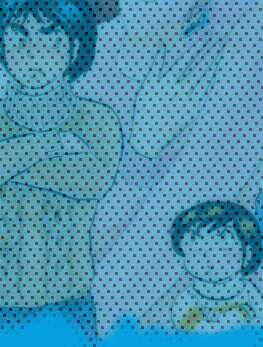
About the Manga
Heralded as one of Rumiko Takahashi's masterpieces, Maison Ikkoku is grounded in a realist tradition and demonstrated the author's talents writing not only stories for the youngest but also for an older set. Published simultaneously with her debut serial, Urusei Yatsura, Maison Ikkoku marked the arrival of one of the most important and celebrated voices in the manga industry for decades to come.
| Monthly and Bi-Weekly Serializations in Big Comic Spirits (ビッグコミックスピリッツ) |
 Unlike Takahashi's other long-running series, Maison Ikkoku did not run in Shonen Sunday, but one of its sister magazines, Big Comic Spirits. If Shonen Sunday is for the teenage reader, then Big Comic Spirits is aimed at the "over 21" crowd. Because Big Comic Spirits is a bi-weekly magazine Takahashi only had to work on two chapters a month instead of four, but she was under an increased workload as it was, because she was writing and drawing Urusei Yatsura in Shonen Sunday throughout Maison Ikkoku's entire run (not an easy feat!!).
Unlike Takahashi's other long-running series, Maison Ikkoku did not run in Shonen Sunday, but one of its sister magazines, Big Comic Spirits. If Shonen Sunday is for the teenage reader, then Big Comic Spirits is aimed at the "over 21" crowd. Because Big Comic Spirits is a bi-weekly magazine Takahashi only had to work on two chapters a month instead of four, but she was under an increased workload as it was, because she was writing and drawing Urusei Yatsura in Shonen Sunday throughout Maison Ikkoku's entire run (not an easy feat!!).
Maison Ikkoku ran for 162 chapters from November 1980 to April 1987. It debuted alongside series such as Naive, Rakuten Kids, Bokkemon, Headgear, and Hoketsu no Hoshi. Of these series only Bokkemon was still around 100 chapters later. Other significant series that debuted during Maison Ikkoku's publication include Oishinbo by Tetsu Kariya and Akira Hanasaki, Crying Freeman by Kazuo Koike and Ryoichi Ikegami and Iron Virgin Jun by Go Nagai. This is also the one of the only place to find the original color illustrations that Takahashi created for the series. Because the magazines are not meant to be kept these color illustrations have been particularly challenging to find. Some have been reprinted infrequently in subsequent editions of the manga but generally speaking acquiring the color artwork from the series (either as original pages or in reprints) is difficult. |
| Tankobon (単行本) |
 After enough chapters had been published in Big Comic Spirits Shogakukan issues a tankobon to collect them. The paper quality is much higher than the cheap newsprint used in the bi-weekly Big Comic Spirits. Rumiko Takahashi also provides an original cover illustration, along with a interior piece of orginal color artwork. Each tankobon usually contained around ten to eleven chapters. Maison Ikkoku was collected into a set of 15 tankoban.
After enough chapters had been published in Big Comic Spirits Shogakukan issues a tankobon to collect them. The paper quality is much higher than the cheap newsprint used in the bi-weekly Big Comic Spirits. Rumiko Takahashi also provides an original cover illustration, along with a interior piece of orginal color artwork. Each tankobon usually contained around ten to eleven chapters. Maison Ikkoku was collected into a set of 15 tankoban.
The original tankobon editions are no longer in print and have been replaced by subsequent editions found below. Big Comic Spirits tankobon are all printed in the Japanese B6 format (12.8 cm × 18.2 cm or 5.04 in × 7.17 in). |
| Wideban (ワイド版) |
 In 1993 Shogakukan released wideban collections of Urusei Yatsura and Maison Ikkoku. The paper quality in wideban is even higher than the tankobon, and all of the color artwork has been transferred to gray scale to give it a much cleaner look. Once again Takahashi provided beautiful artwork for the covers, each one depicting a different daily routine in Kyoko's life. The interior of the books also feature color illustrations from the series that were not collected in the tankobon, so fans of Takahashi's color drawings should definetly look for these. Wideban are larger than tankobon, and so you get more chapters for your money. Maison Ikkoku was collected in ten wideban books.
In 1993 Shogakukan released wideban collections of Urusei Yatsura and Maison Ikkoku. The paper quality in wideban is even higher than the tankobon, and all of the color artwork has been transferred to gray scale to give it a much cleaner look. Once again Takahashi provided beautiful artwork for the covers, each one depicting a different daily routine in Kyoko's life. The interior of the books also feature color illustrations from the series that were not collected in the tankobon, so fans of Takahashi's color drawings should definetly look for these. Wideban are larger than tankobon, and so you get more chapters for your money. Maison Ikkoku was collected in ten wideban books.
|
| Bunkoban (文庫版) |
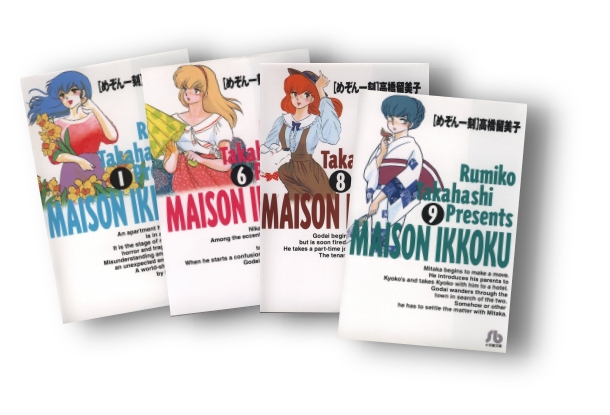 Bunkoban are pocket manga. Personally, I think Shogakukan was just enjoying reaping the benefits of the series popularity and wanted another way to make some money from it, but I digress. Bunkoban are smaller, square-bound editions of the series, and are perfect for taking on vacations and reading on the go (bunkoban are A6 format, meaning they are 105 mm × 148 mm or 4.1 in × 5.8 in). The series was released in this format in 1997.
Bunkoban are pocket manga. Personally, I think Shogakukan was just enjoying reaping the benefits of the series popularity and wanted another way to make some money from it, but I digress. Bunkoban are smaller, square-bound editions of the series, and are perfect for taking on vacations and reading on the go (bunkoban are A6 format, meaning they are 105 mm × 148 mm or 4.1 in × 5.8 in). The series was released in this format in 1997.
|
| Soushuuhen (総集編) |
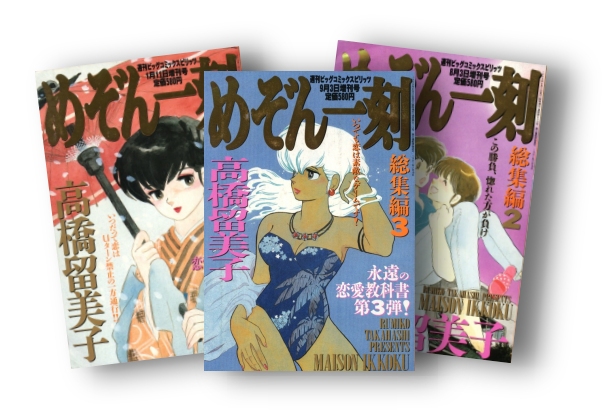 Beginning publication in 1998 the soushuuhen (Entire Collection Compliation) is a slightly more pricey version of Maison Ikkoku that ended production in 2000. Only for the most hardcore fans, the soushuuhen edition was unfinished in Japan, six volumes were published, only reaching chapter 78, Nikaido's first appearance. The soushuuhen are probably most notable for their extremely clean presentation and original color pages that look even better in this format than they did when they originally appeared in Big Comic Spirits. Unfortunately, not all the color pages were reprinted in this format.
Beginning publication in 1998 the soushuuhen (Entire Collection Compliation) is a slightly more pricey version of Maison Ikkoku that ended production in 2000. Only for the most hardcore fans, the soushuuhen edition was unfinished in Japan, six volumes were published, only reaching chapter 78, Nikaido's first appearance. The soushuuhen are probably most notable for their extremely clean presentation and original color pages that look even better in this format than they did when they originally appeared in Big Comic Spirits. Unfortunately, not all the color pages were reprinted in this format.
|
| Shinsoban (新装版) |
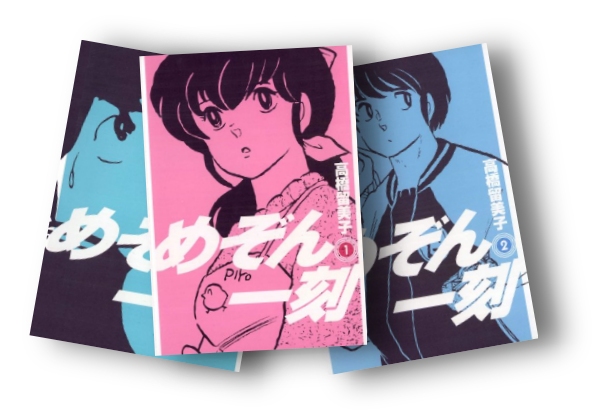 As of 2007 this is the newest edition of the Maison Ikkoku manga in Japan. The shinsoban are done in the same style as the shinsoban sets for Ranma 1/2, and Urusei Yatsura in terms of cover design. Like the Ranma 1/2 edition, these have no special content, colorized covers using interior black and white artwork and are generally seen as replacements for the out-of-print tankobon editions.
As of 2007 this is the newest edition of the Maison Ikkoku manga in Japan. The shinsoban are done in the same style as the shinsoban sets for Ranma 1/2, and Urusei Yatsura in terms of cover design. Like the Ranma 1/2 edition, these have no special content, colorized covers using interior black and white artwork and are generally seen as replacements for the out-of-print tankobon editions.
|
| My First Wide |
 Another cheap way to collect the series, this edition is by far the tallest and fattest version of Maison Ikkoku, collecting the entire series in six huge telephone book sized editions. Each book retailed for a mere 571 yen.
Another cheap way to collect the series, this edition is by far the tallest and fattest version of Maison Ikkoku, collecting the entire series in six huge telephone book sized editions. Each book retailed for a mere 571 yen.
|
| Big Comic Compact |
 On the surface these appear to be inexpensive magazines re-collecting the series on the same cheap newsprint that Maison Ikkoku was originally printed on in its bi-weekly format in Big Comic Spirits. However a closer examination will uncover a wealth of bonus material. Each of the 15 editions is packed with interviews with celebrity fans of the series, as well as exclusive reprints of the color pages from their original chapters. For the collector who purchases all 15, mailing in the UPC code will net them an apron just like Kyoko's.
On the surface these appear to be inexpensive magazines re-collecting the series on the same cheap newsprint that Maison Ikkoku was originally printed on in its bi-weekly format in Big Comic Spirits. However a closer examination will uncover a wealth of bonus material. Each of the 15 editions is packed with interviews with celebrity fans of the series, as well as exclusive reprints of the color pages from their original chapters. For the collector who purchases all 15, mailing in the UPC code will net them an apron just like Kyoko's.
These are analogous to the "My First Big" editions that are lower quality, disposable digests versions of Takahashi's other manga such as Urusei Yatsura and Ranma 1/2. These also occasionally included one of Takahashi's short stories from Big Comic Original in them as well such as The Executive's Dog. |
| Art Books |
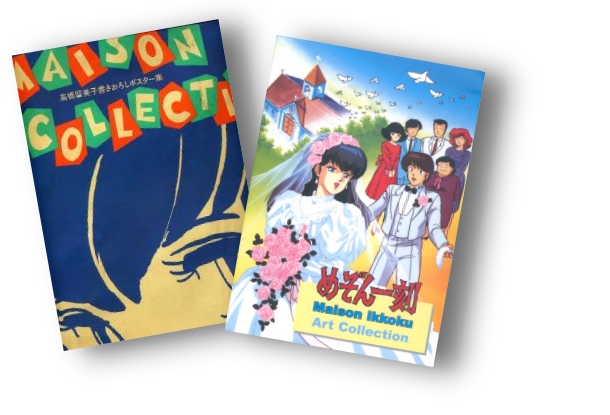 Maison Ikkoku had relatively few art books dedicated specifically to it compared to the number of publications Urusei Yatsura recieved at the time.
Maison Ikkoku had relatively few art books dedicated specifically to it compared to the number of publications Urusei Yatsura recieved at the time.
Released in 1988 Maison Ikkoku Collected Reproductions of Original Art - Thoughts (めぞん一刻 描きおろし複製原画集 想い/Maison Ikkoku Kakioroshi Fukusei Genga-shuu - Omoi), also called The Memorial Illustrations of Maison Ikkoku, is a portfolio that has eight images inside, no text, and is a companion piece to the similarly designed Urusei Yatsura - The Original Illustrations Selected by Rumiko Takahashi art collection. The next set are the exceedingly obscure Maison Ikkoku Art Collection is the only true art "book" of the series, this focuses on the anime rather than the manga. Do not let the garish cover fool you, this book is a must-buy for any fan of the series. The book is packed with practically every piece of production art used on the animated series, character turn-arounds for certain key episodes, original artwork used in the Sound Theater CDs and it is all on high-quality, glossy paperstock. Not a book per se, the Maison Collection - Rumiko Takahashi New Poster Collection (Maison Collection 高橋留美子書き下ろしポスター集/Maison Collection Takahashi Rumiko Kakioroshi Posutaa-shuu) is a large envelop with loose, unbound poster artwork from Maison Ikkoku inside. The eight posters were all made especially for this release. A few of the items were later reused for promotional material but generally speaking the images are not often seen outside of this collection. A number of artbooks have also been released that feature all of Rumiko Takahashi's work and are not focused solely on one series. Of those: Rumiko Takahashi Exhibition - It's a Rumic World (高橋留美子展 It's a Rumic World/Takahashi Rumiko Ten It's a Rumic World) was published in 2007 and sold at the gallery exhibition of her work that ran in Japan from July 30th - August 11th of that year. It features color artwork from Urusei Yatsura, Maison Ikkoku, Ranma 1/2, Inuyasha, One-Pound Gospel, Mermaid Saga and a number of her short stories. One of the best overall overviews of Takahashi's career is Rumic World 35 which is a three volume boxset comprising All Star, Showtime and the collected children's manga MOON, The Great Pet King. The first two volumes mentioned contain character profiles, items, locations and color art for all of her series up to Kyokai no Rinne to celebrate 35th anniversary of her debut. |
| Miscellaneous Books |
 Over the years Kitty Animation Circle newsletters transitioned from a fold-out poster called Urusei Yatsura Fanclub (うる星やつら ファンクラブ/Urusei Yatsura Fankurabu) in 1982 to a small pamphlet called Movement (ムーヴメント) that was published quarterly in 1986, going monthly in 1987 and was eventually rechistened We'll (ウィル) in 1993. The pamphlets featured information on a number of Kitty Animation Projects (but primarily focused on Urusei Yatsura, Maison Ikkoku and Ranma 1/2). Publication ceased in December 2000. Kitty Animation Circle would publish some one off magazine style pieces as well such as Urusei Yatsura/Maison Ikkoku Summer Carnival (うる星やつら めぞん一刻 夏カーニバル/Urusei Yatsura Maison Ikkoku Natsu Kaanibaru) and Gather With Anime from All Over the Country(全国のアニメと集まれ/Zenkoku no Anime to Atsumare). None of these items focused primarily on Maison Ikkoku but a great deal of Maison Ikkoku coverage was mixed in with news about other Kitty Animation properties.
Over the years Kitty Animation Circle newsletters transitioned from a fold-out poster called Urusei Yatsura Fanclub (うる星やつら ファンクラブ/Urusei Yatsura Fankurabu) in 1982 to a small pamphlet called Movement (ムーヴメント) that was published quarterly in 1986, going monthly in 1987 and was eventually rechistened We'll (ウィル) in 1993. The pamphlets featured information on a number of Kitty Animation Projects (but primarily focused on Urusei Yatsura, Maison Ikkoku and Ranma 1/2). Publication ceased in December 2000. Kitty Animation Circle would publish some one off magazine style pieces as well such as Urusei Yatsura/Maison Ikkoku Summer Carnival (うる星やつら めぞん一刻 夏カーニバル/Urusei Yatsura Maison Ikkoku Natsu Kaanibaru) and Gather With Anime from All Over the Country(全国のアニメと集まれ/Zenkoku no Anime to Atsumare). None of these items focused primarily on Maison Ikkoku but a great deal of Maison Ikkoku coverage was mixed in with news about other Kitty Animation properties.
|
| Foreign Editions |
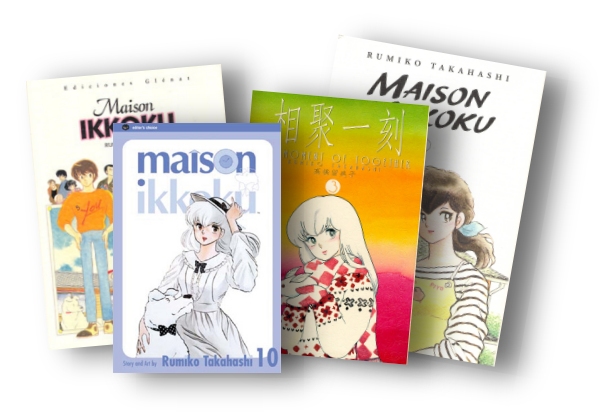 Rumiko Takahashi's works are published in a variety of languages. The American distribution rights are handled by Viz Media, one of the leading manga translation companies which is owned by Shogakukan and as of 2002, Shueisha. A comic book was released every month that collected two chapters from the series. About every six months, Viz collected the chapters as a graphic novel. Fourteen graphic novels of the series were released.
Rumiko Takahashi's works are published in a variety of languages. The American distribution rights are handled by Viz Media, one of the leading manga translation companies which is owned by Shogakukan and as of 2002, Shueisha. A comic book was released every month that collected two chapters from the series. About every six months, Viz collected the chapters as a graphic novel. Fourteen graphic novels of the series were released.
In 2004, Viz began re-releasing the collected graphic novels in a new second edition. Although smaller in size, this new release was far superior to the old graphic novels in that the artwork was restored to its original right-to-left layout, the chapters are broken up into the Japanese count, now making the complete run available in 15 books, and most importantly, the missing chapters from the first run were translated and restored to the series, finally giving fans a truly complete look at the series in English. A third edition of the series with a fresh translation was released starting in 2019. In addition to the English version, Maison Ikkoku has been published in Italian, French, Spanish and Chinese. |